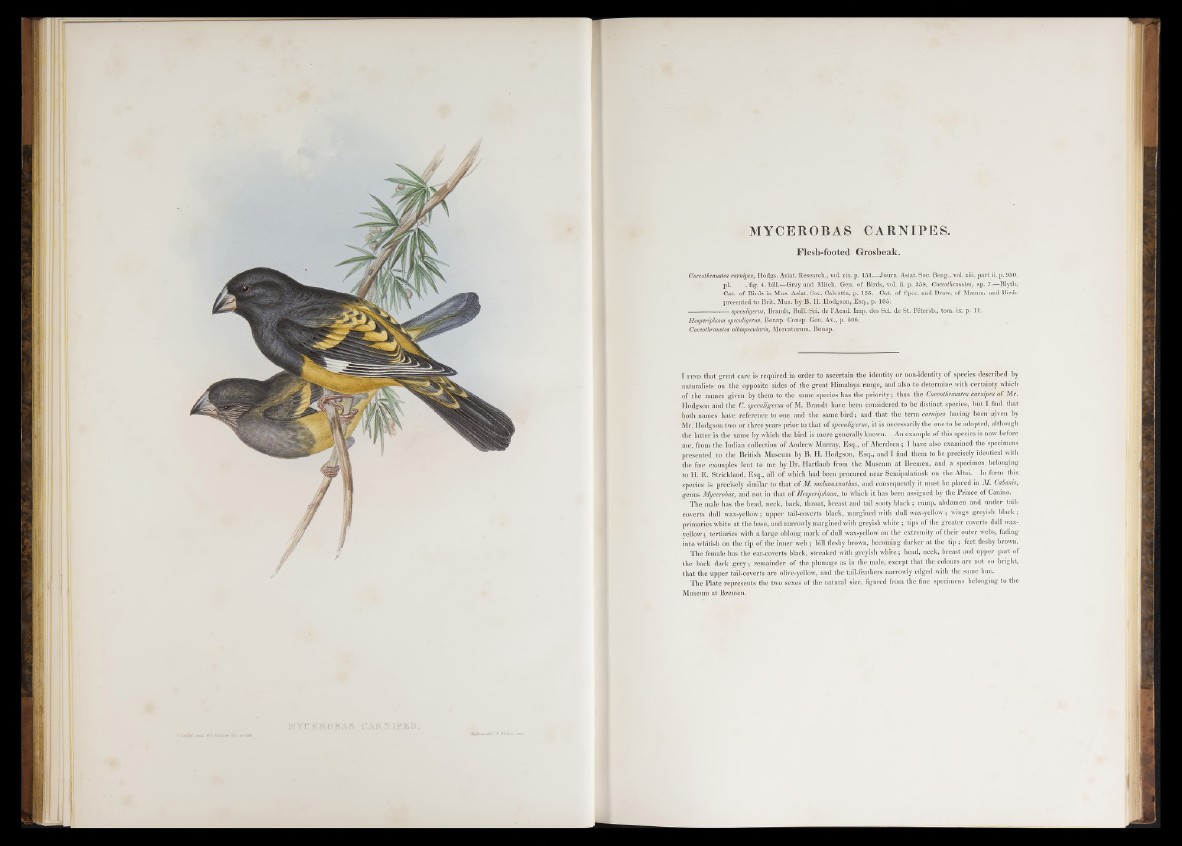
r C E R
MYCEROBAS CARNIPES.
Flesh-footed Grosbeak.
Coccothraustes car nip es, Hodgs. Asiat. Research., vol. xix. p . 151.—Journ. Asiat. Soc. Beng., vol. xiii. p a rt ii. p. 950.
pi. . fig. 4. bill.-—Gray and Mitch. Gen. o f Birds, vol. ii; p. 358, Coccothraustes, sp. 7.— Blyth,
Cat. o f Birds in Mus. Asiat. Soc. Calcutta, p. 125.—Cat. o f Spec, and Draw, of Mamm. and Birds
presented to Brit. Mus. by B. H. Hodgson, Esq., p. 105.
---------------------speculigerus, Brandt, Bull. Sci. de l’Acad. Imp. des Sci. de St. Petersb., tom. ix. p. 11.
Hesperiphona speculigerus, Bonap. Consp. Gen. Av., p. 506.
Coccothraustes albispecularis, Mercatorum, Bonap.
I f i n d that great care is required in order to ascertain the identity or non-identity of species described by
naturalists on the opposite sides of the great Himalaya range, and also to determine with certainty which
o f the names given by them to the same species has the prio rity ; thus the Coccothraustes carnipes of Mr.
Hodgson and the C. speculigerus of M. Brandt have been considered to be distinct species, but I find that
both names have reference to one and the same b ird ; and that the term carnipes having been given by
Mr. Hodgson two or three years prior to that o f speculigerus, it is necessarily the one to be adopted, although
the latter is the name by which the bird is more generally known. An example o f this species is now before
me, from the Indian collection of Andrew Murray, Esq., of Aberdeen; I have also examined the specimens
presented to the British Museum by B. H. Hodgson, Esq., and I find them to be precisely identical with
the fine examples lent to me by Dr. Hartlaub from the Museum a t Bremen, and a specimen belonging
to H. E. Strickland, Esq., all of which had been procured near Semipalatinsk on the Altai. In form this
species is precisely similar to that of M. melanoxanthus, and consequently it must be placed in M. Cabanis,
genus Mycerobas, and not in that of Hesperiphona, to which it has been assigned by the Prince of Canino.
The male has the head, neck, back, throat, breast and tail sooty b lack ; rump, abdomen and under tail-
coverts dull wax-yellow; upper tail-coverts black, margined with dull wax-yellow; wings greyish b lack ;
primaries white at the base, and narrowly margined with greyish w hite; tips o f the greater coverts dull wax-
yellow ; tertiaries with a large oblong mark o f dull wax-yellow on the extremity of their outer webs, fading
into whitish on the tip of the inner web ; bill fleshy brown, becoming darker at the tip ; feet fleshy brown.
The female has the ear-coverts black, streaked with greyish white; head, neck, breast and upper part of
the back dark g re y ; remainder of the plumage as in the male, except that the colours are not so bright,
that the upper tail-coverts are olive-yellow, and the tail-feathers narrowly edged with the same hue.
The Plate represents the two sexes of the natural size, figured from the fine specimens belonging to the
Museum at Bremen.